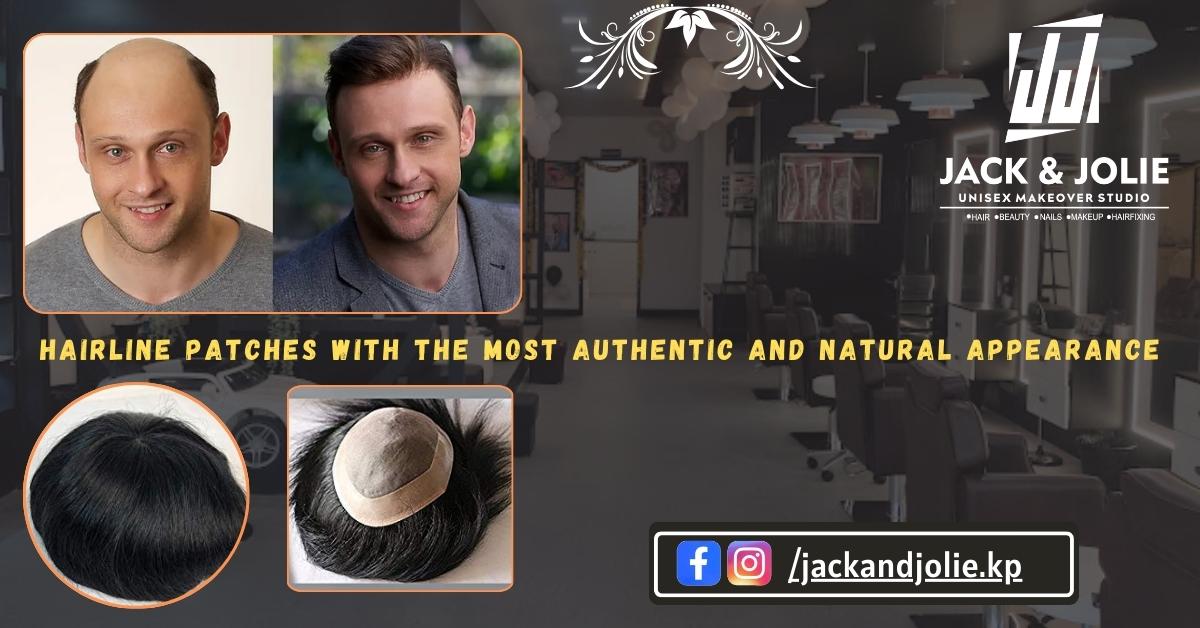Hairline patches with the most authentic and natural appearance
For men grappling with hair loss, discovering hair replacement solutions that appear natural can be a daunting and disheartening journey. The quest is for a remedy that not only reinstates confidence but also enables facing the world without the burden of self-consciousness about a receding hairline. In India, there exist select options that offer meticulously crafted, natural-looking hairline patches tailored explicitly for Indian men. These patches seamlessly integrate with your existing hair, individually customized to harmonize with your distinct hair color and skin tone. Offering an imperceptible solution, they effectively camouflage receding hairlines or bald spots. Continue reading to explore the most authentically natural hairline patches available in India, providing a discreet answer to hair loss concerns, all without the inconvenience of frequent salon visits. Armed with the right patch, each day can be met with a renewed sense of confidence in one’s appearance.
A natural hairline is characterized by several factors that contribute to its realistic appearance. These elements include:
Natural Hairline: What Makes It Look Realistic?
1. Direction of Hair Growth
The hair in a natural hairline should follow the natural pattern of hair growth. This means that the hair follicles are implanted at the correct angles to mimic the way hair naturally grows from the scalp.
2. Density Variation
A realistic hairline incorporates variations in hair density. It’s not uniformly thick but instead has subtle variations to imitate the natural look of a person’s hair.
3. Irregularities
Natural hairlines are not perfectly straight or symmetrical. They often have irregularities, such as slight asymmetry or variations in the placement of individual hair follicles.
4. Gradual Transition
A well-crafted natural hairline transitions gradually from the forehead to the thicker areas of the scalp. There should not be a sudden, noticeable change in density.
5. Single-Hair Follicular Units
The use of single-hair follicular units in the frontal hairline contributes to a more natural appearance. This involves transplanting individual hair follicles rather than larger grafts.
6. Hairline Design Matching Facial Features
The design of the hairline should complement the individual’s facial features, ensuring it looks harmonious and proportional.
7. Texture and Curl Pattern
The texture and curl pattern of the transplanted hair should match the person’s natural hair to achieve a seamless blend.
8. Age-Appropriate Design
A natural hairline takes into account the person’s age, considering that hairlines tend to recede or change slightly with age.
When these elements are carefully considered and executed, the result is a natural hairline that is virtually indistinguishable from one’s original hair, contributing to a realistic and aesthetically pleasing appearance.
What to Consider When Choosing a Natural-Looking Hairline Patch
When it comes to choosing a hairline patch, achieving a natural-looking result is of utmost importance. After all, the goal is to seamlessly blend the patch with your existing hair and create a realistic appearance. There are several factors to consider when selecting a hairline patch that will give you the most natural look possible.
First and foremost, it’s crucial to choose a hairline patch that matches your natural hair color and texture. This ensures that the patch seamlessly integrates with your existing hair, making it virtually undetectable. Whether you have straight, wavy, or curly hair, there are options available to suit your specific needs.
Additionally, the material of the hairline patch plays a significant role in achieving a natural look. Opt for patches made from high-quality materials that mimic real human hair. These patches not only look more authentic but also provide better durability and longevity.
Another important consideration is the size and shape of the hairline patch. It should closely resemble your original hairline to create a seamless transition between the patch and your natural hair. Take into account factors such as forehead shape and size when choosing an appropriate patch for yourself.
Furthermore, pay attention to how well the adhesive or attachment method works with your skin type. A secure attachment ensures that the patch stays in place throughout daily activities without drawing unnecessary attention.
Lastly, consider seeking professional guidance when selecting a natural-looking hairline patch. Hair loss specialists or professionals in this field can offer valuable advice based on their expertise and experience.
By taking these factors into consideration – matching color and texture, quality material selection, proper sizing and shaping, reliable attachment methods – you can confidently choose a natural-looking hairline patch that enhances your appearance discreetly while boosting your confidence levels.
Color and Texture Match
Color and texture matching are crucial considerations when selecting a hairline patch to ensure a seamless and natural appearance. The patch should closely match the color of your existing hair, taking into account any variations or highlights. Additionally, the texture of the patch should mimic the natural feel of your hair, whether it’s straight, wavy, or curly. Achieving a harmonious color and texture match enhances the overall realism of the hairline, making the patch virtually indistinguishable from your own hair.
Application
1. Androgenetic Alopecia (Male and Female Pattern Baldness)
Hair patches can be used to cover areas affected by genetic hair loss, providing a non-surgical solution for those seeking to restore a fuller appearance.
2. Alopecia Areata
Individuals with alopecia areata, an autoimmune condition causing hair loss in patches, may use hair patches to conceal affected areas and enhance their overall look.
3. Chemotherapy-Induced Hair Loss
Cancer patients undergoing chemotherapy often experience hair loss. Hair patches can be applied to help manage the aesthetic impact of this temporary hair loss.
4. Receding Hairline
Hair patches can be used to create a more defined and natural-looking hairline, addressing concerns related to receding hairlines.
5. Thinning Hair
People with thinning hair, whether due to aging or other factors, may opt for hair patches to add volume and thickness to their existing hair.
6. Cosmetic Enhancements
Some individuals use hair patches for cosmetic reasons, desiring a change in hairstyle or hair color without committing to permanent alterations.
When considering the application of a hair patch, factors such as color matching, texture, comfort, and ease of maintenance are important to ensure a natural and seamless integration with the individual’s existing hair. It’s essential to consult with a professional to choose the right type of hair patch and ensure a proper application for the desired result.
How long do hairline patches last?
The lifespan of hairline patches can vary based on several factors, including the type of patch, the materials used, and individual care and maintenance. Here are some general guidelines for different types of hairline patches:
1. Temporary or Clip-In Patches
Duration: These are designed for short-term use and are not meant to be worn continuously.
Lifespan: Typically last for the day and are removed before sleeping.
2. Semi-Permanent Patches
Duration: Meant for longer use but may need periodic removal for cleaning or adjustment.
Lifespan: Can last a few weeks to a few months, depending on the quality and care.
3. Permanent or Surgically Implanted Patches
Duration: Intended for long-term or permanent use.
Lifespan: Can last for many years or even a lifetime with proper care.
4. Custom Hair Systems
Duration: These are typically semi-permanent solutions.
Lifespan: Can last several months to a year or more, depending on the materials used and maintenance.
Factors influencing the longevity of hairline patches include the quality of the patch, the attachment method, the wearer’s lifestyle, and how well the patch is cared for. Regular maintenance, cleaning, and following the manufacturer’s or stylist’s care instructions can contribute to extending the lifespan of the patch.
It’s important to note that even permanent or semi-permanent solutions may require periodic adjustments or replacements over time, as hair growth, changes in style preference, or wear and tear can impact their effectiveness. Consulting with a professional stylist or technician can provide personalized guidance on the maintenance and longevity of specific hairline patches.
Can I shower, swim or exercise while wearing a hairline patch?
The ability to shower, swim, or exercise while wearing a hairline patch depends on the type of patch and the attachment method used. Here are some general guidelines
1. Temporary or Clip-In Patches
Showering: Generally, it’s advisable to remove clip-in patches before showering to prevent them from getting wet and potentially slipping or losing their shape.
Swimming/Exercise: It’s recommended to remove them before swimming or engaging in intense exercise to avoid displacement.
2. Semi-Permanent Patches
Showering: Some semi-permanent patches can withstand regular showers, but it’s essential to follow the care instructions provided by the manufacturer or stylist.
Swimming/Exercise: It’s advisable to check with the supplier or stylist regarding specific recommendations for swimming and exercise. Chlorinated or saltwater, as well as excessive sweating, can impact the longevity of the patch.
3. Permanent or Surgically Implanted Patches
Showering: In most cases, individuals with surgically implanted patches can shower as usual, following any post-surgery care instructions provided by their surgeon.
Swimming/Exercise: After surgical procedures, it’s important to follow the surgeon’s advice regarding swimming and exercise. There may be restrictions during the initial healing period.
4. Custom Hair Systems
Showering: Custom hair systems may be designed to withstand regular showers, but specific care instructions should be followed.
Swimming/Exercise: Consult with the stylist or manufacturer to determine the system’s suitability for swimming and exercise. Factors such as adhesive strength and the type of materials used can influence these activities.
Always follow the care instructions provided by the patch manufacturer, stylist, or surgeon to ensure the longevity and proper maintenance of the hairline patch. If in doubt, consult with a professional who can provide guidance based on the specific type of patch you are using.
conclusion
The availability of natural-looking hairline patches in India provides a discreet solution to hair loss concerns. Understanding the elements of a natural hairline, choosing patches carefully, considering application scenarios, understanding lifespan factors, and adhering to care guidelines empower individuals to confidently navigate the journey of hair replacement, embracing a renewed sense of confidence in their appearance.


